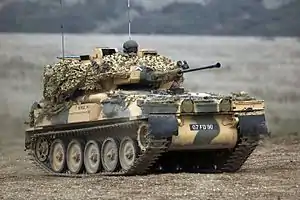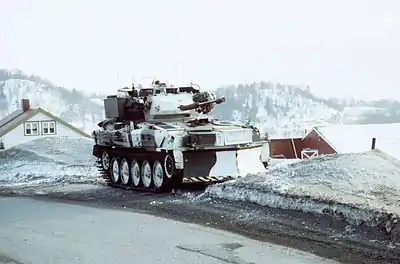FV107 Scimitar
The FV107 Scimitar is an armoured tracked military reconnaissance vehicle (sometimes classed as a light tank) formerly used by the British Army, until it was retired from active service in April 2023.[2] It was manufactured by Alvis in Coventry. It is very similar to the FV101 Scorpion, but mounts a high-velocity 30 mm L21 RARDEN cannon instead of a 76 mm gun. It was issued to Royal Armoured Corps armoured regiments in the reconnaissance role. Each regiment originally had a close reconnaissance squadron of five troops, each containing eight FV107 Scimitars. Each Main Battle Tank Regiment also employed eight Scimitars in the close reconnaissance role.
| FV107 Scimitar | |
|---|---|
 Scimitar performing a firepower demonstration on Salisbury Plain | |
| Type | Reconnaissance vehicle |
| Place of origin | United Kingdom |
| Service history | |
| Wars |
|
| Production history | |
| Manufacturer | Alvis / BAE Systems Land & Armaments |
| No. built | over 600 (for UK)[1] |
| Specifications | |
| Mass | 7.8 tonnes |
| Length | 4.9 m |
| Width | 2.2 m |
| Height | 2.1 m |
| Crew | 3 |
| Armour | aluminium armour |
Main armament | 30 mm L21 RARDEN cannon A.P.D.S. (Armour Piercing Discarding Sabot). H.E. (High Explosive). D.S.R.R. (Discarding Sabot Reduced Range) (training) Prac. (H.E. Practice) (training) |
Secondary armament | Coaxial 7.62 mm L37A1 MG |
| Engine | Cummins BTA 5.9 diesel 190 hp (142 kW) |
| Drive | tracked, with 14 lbf/in2 (0.98 kg/cm2) ground pressure |
| Suspension | Torsion bar |
Operational range | 450 km |
| Maximum speed | 50 mph (80.5 km/h) |
Development
The FV107 Scimitar is one of the CVR(T) series of vehicles. It entered service in 1971.
Initially, the engine was the Jaguar J60 4.2-litre 6-cylinder petrol engine, the same as used by several Jaguar cars. This was replaced by a Cummins BTA 5.9 diesel engine in British Army Scimitars under the CVR(T) Life Extension Program (LEP).
The UK initiated the Tactical Reconnaissance Armoured Combat Equipment Requirement (TRACER) to replace the Sabre and Scimitar.[3] In 1996 the U.S. joined in on the project.[4] In 2001, both the UK and U.S. dropped out of the joint programme.[5]
As of 2023, the Scimitar's intended replacement in British service is a variant of the Ajax fitted with a CT40 cannon.[6] The Scimitar was retired from British service in 2023. The Warrior is being used as a temporary stop-gap, until Ajax reaches initial operating capability.[2][7]
Scimitar Mk II
Following a risk mitigation programme, in December 2010 a contract was awarded for the development, testing and management of an upgraded Scimitar.[8] This was undertaken by the Vehicles Military & Technical Services team, BAE Systems Telford, which co-ordinated the build of 50 vehicles at the nearby DSG (Defence Support Group), Donnington, to be completed in early 2012. The Scimitar Mark 2 combat vehicle is one of five enhanced CVR(T) types.[9] It was created in early 2010, and continues in service.[10]
The Scimitar Mk II was:
- Rehulled to give better mine-blast protection for troops
- Improved armour fitted to enhance resistance to blasts and ballistic threats
- Provide mine-protected (suspended and piston-mounted) seating in every crew position
- Improve available space and improve crew conditions
- Mitigate repairs while reducing maintenance and life-cycle costs, and extend in-service life.
The resulting vehicles have since been re-engined with a Cummins BTA 5.9 litre diesel engine and David Brown TN15E+ automatic gearbox.[11] In addition to providing power for an air conditioning system, the new more fuel-efficient engine extends the vehicle's operational range, while the re-designed internal layout allows better-protected fuel tanks to be repositioned for reduced vulnerability to blast and ballistic threats.
The new engine and transmission package promised straightforward servicing and support for the Mk II during its in-service life, refurbished dampers simultaneously improving crew comfort - and hence reducing fatigue - while extending the life of vehicle components and maintaining the tactical mobility of the original vehicle despite an increase to an operation weight of c12,000 kg.
BAE Systems have proposed improved road wheels, new conventional metal tracks with guaranteed mileage (which could reduce the vehicle's running costs) and continuous 'rubber' band tracks, which significantly decrease both vibration and noise, allowing crew to operate more effectively and for longer, even in the harshest environments, while reducing the vehicle's acoustic signature.
Combat use
Two troops from B Squadron, Blues and Royals served in the Falklands War. One troop was equipped with four Scorpions, the other with four Scimitars. These CVR(T)s were the only armoured vehicles used in action by the British Army during the conflict.[12] At least one Scimitar was seriously damaged by an Argentinian landmine, but the crew were unscathed, and the vehicle was salvaged by a Chinook HC.1 helicopter[13] and soon brought back into service by the attached REME section. Scorpions and Scimitars also provided air defence support with machine guns and 30 mm guns; on 23 May 1982, a Scimitar claimed a 30 mm hit on a Skyhawk at 1,000 m.[14]
First Gulf War, 1st The Queen's Dragoon Guards, with attached reinforcements, fought as a regiment during this war and was equipped with Scimitar. A troop of Scimitars engaged and knocked out Iraqi T-62s, penetrating their frontal armour with sabot rounds. One Scimitar was engaged and hit by an Iraqi T-55 and the penetrating round passed through the thin aluminium armour without injuring the crew.
Scimitars of C Squadron were used in the Battle of Al Faw in the opening days of the 2003 Invasion of Iraq. Plans for an amphibious landing by Scimitars were abandoned due to extensive mining of the beaches; instead, they crossed into Iraq by land.
In Afghanistan, during Operation Herrick, Scimitars were deployed either in standard troop organisations or as part of Jackal composite troops, in which role they provided additional firepower to complement the Jackal's high mobility.
Additional specifications

- Ground clearance: 0.35 m
- Main armament: 30 mm L21 RARDEN cannon. (Fires at up to 90 rounds per minute)
- Ammunition types:
- High Explosive Incendiary (HEI)
- High Explosive (HE)
- Armour Piercing (AP)
- APSE (Armour Piercing Secondary Effects)
- Armour Piercing Discarding Sabot-Tracer (APDS-T)
- Additional defence: 2 × 4-barrel smoke launchers.
- Ammunition stores:
- As with all British armoured vehicles, Scimitar is equipped with a forced air system, so the crew could lock down in a CBRN environment. For this reason, the vehicle is equipped with a boiling vessel (or "BV"), to cook and make hot drinks.[15]
Operators
Current operators
_Scimitar.png.webp)
 Latvia – 123 units
Latvia – 123 units
In September 2014, Latvia signed a contract with Great Britain for the purchase of 123 Scimitars as part of the Latvian National Armed Forces infantry brigade mechanization program.[16]
 Ukraine – 23 units
Ukraine – 23 units
In August 2023, 23 Scimitar MK IIs we delivered to Ukraine by Great Britain to repel the Russian invasion of Ukraine.[17]
Former operators
 United Kingdom – 325 units[18]
United Kingdom – 325 units[18]
The Scimitar was used by the three formation reconnaissance regiments of the British Army.
After the Strategic Defence and Security Review in 2010, some regiment's Challenger 2 tanks were replaced with CVR(T) Scimitars.[19]
The Scimitar was retired from active service in April 2023.[2]
See also
- CVR(T) (Combat Vehicle Reconnaissance – Tracked) family of vehicles.
- M3 Bradley Cavalry Fighting Vehicle - similar role
References
- Staff Writer, "Alvis FV107 Scimitar: Armed Reconnaissance Vehicle (1971)", Military Factory, retrieved 11 October 2021
- "SOLDIER - Page 13". edition.pagesuite.com. Retrieved 15 July 2023.
- Baumgardner, Neil (8 June 2001). "Britain Seeking Information On Off-The-Shelf Vehicles For FRES Program". Defense Daily International. ProQuest 217294908. Retrieved 17 February 2022.
- "U.S., U.K. Sign Letter of Intent for Work on Future Scout Vehicle". Inside the Army. Vol. 8, no. 42. Inside Washington Publishers. 21 October 1996. p. 5. JSTOR 43979553. Retrieved 8 February 2022.
- Winograd, Erin Q. (22 October 2001). "But Technology Will Not Be Abandoned: British, U.S. Officials Announce an End to Joint Future Scout Program". Inside the Army. Vol. 13, no. 42. Inside Washington Publishers. pp. 1, 9–11. JSTOR 24819092. Retrieved 8 February 2022.
- Tong, Michael (6 September 2019). "British Army vehicle procurement: headlights at the end of the tunnel?". International Institute for Strategic Studies. Retrieved 16 July 2023.
- Allison, George (21 March 2023). "Troubled Ajax payments resume, gets new in-service date". Retrieved 16 July 2023.
- Foss, Christopher (2015). "On the mend: British Army looks to refreshed AFVs" (PDF). Jane's International Defence Review.
- "Up-armoured vehicles begin Afghanistan operations". GOV.UK.
- "CVRT Scimitar Mk 2 Mark 2 Light reconnaissance armoured vehicle". www.armyrecognition.com. Retrieved 21 March 2016.
- Gelley, David (21 March 2016). "Whitham Specialist Vehicles Limited". www.mod-sales.com. Whitham Specialist Vehicles Limited. Retrieved 21 March 2016.
- Foss & Sarson, p. 21
- Andrew Jones, "British Armor in the Falklands", ARMOR, March 1983 pp. 26–27
- War Machines, Limited publishing, Italian version De Agostini, 1983, p.235
- "Doug's 'HEAVY METAL' GALLERY". Archived from the original on 26 December 2008.
- "Latvian army purchases UK armoured combat vehicles".
- Oryx. "A Cuppa For Conquest: UK Military Aid To Ukraine". Oryx. Retrieved 1 September 2023.
- "UK Defence: British Army estimated operational armoured vehicle fleet". european-defence.co.uk. January 2008. Archived from the original on 14 January 2013. Retrieved 9 January 2008.
- http://www.army.mod.uk/documents/general/20130703-A2020_Update.pdf%5B%5D the two regiments "reduced" from armoured regiments to armoured cavalry are the Royal Dragoon Guards and the Royal Scot Dragoon Guards
- Ondrejka, Jan; Stojar, Richard (2004). "Belgian armed forces: trends in development" (PDF). Ministry of Defence of the Czech Republic. Archived from the original (PDF) on 27 December 2004. Retrieved 9 January 2008.
- "La Défense au rapport". page 55 (in French). Belgian Ministry of Defence. January 2006. Archived from the original on 31 July 2013. Retrieved 9 January 2008.